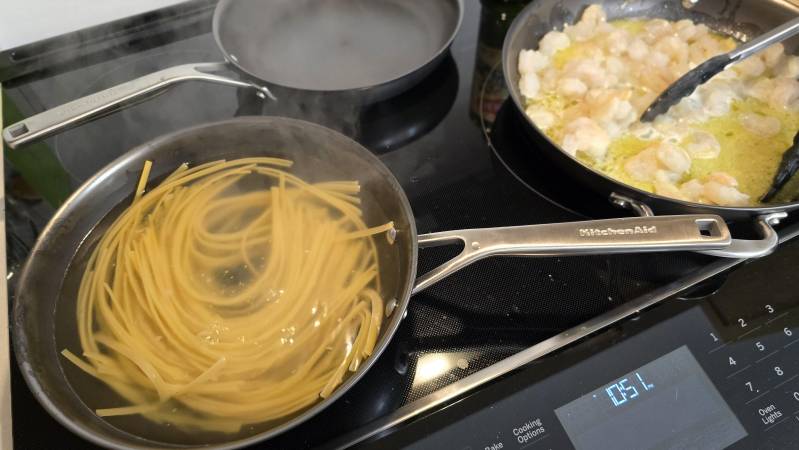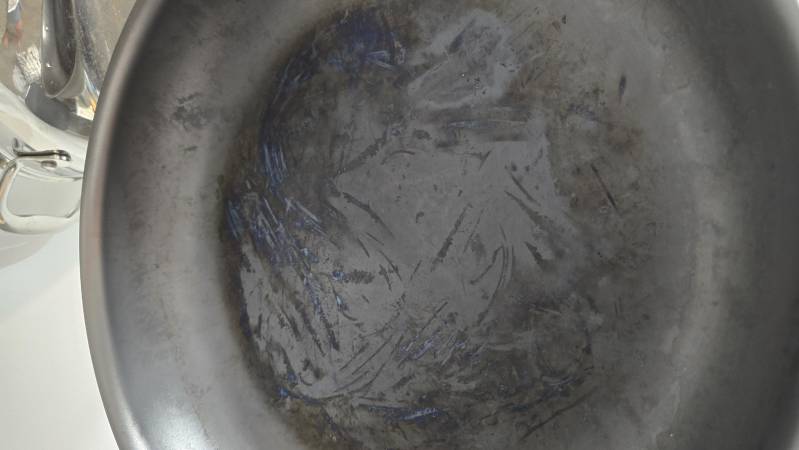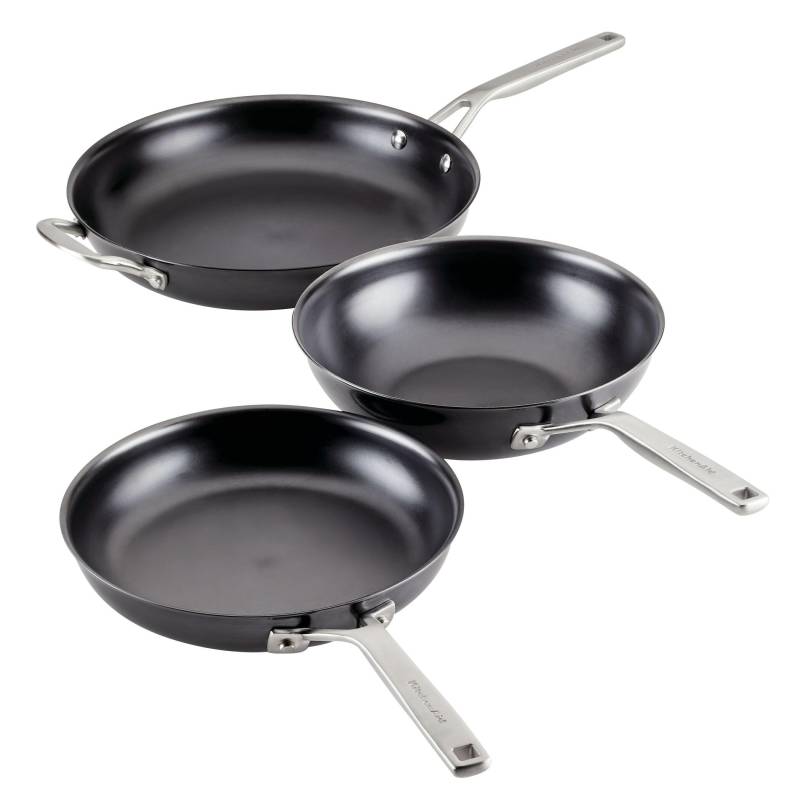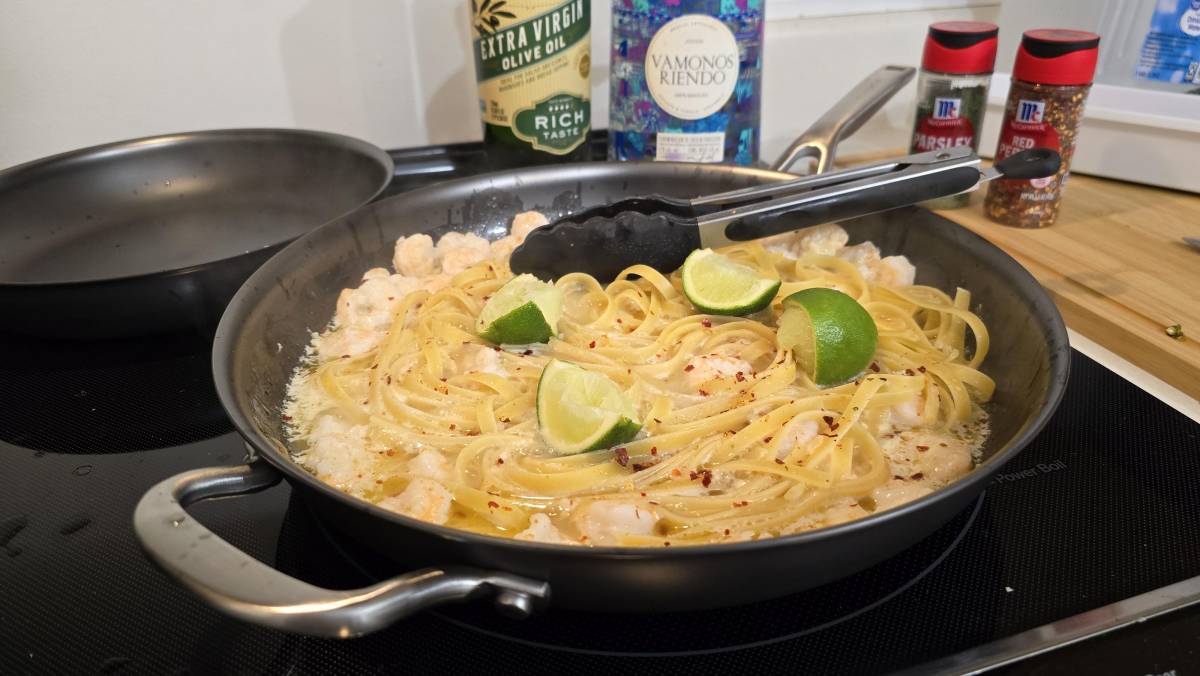I'm obessed with cast iron pans for cooking. They hold their heat, can withstand high temperatures and they don't have a problem being placed in the oven for the perfect reverse sear steak. There's a whole bunch of other benefits that for my style of cooking make them a cherished part of my kitchen. Unfortunately, with my new condo and a very fancy new cooktop, the instructions had a call out that I should avoid using cast iron cookware. What to do!? The answer came in the form of a product pitch from KitchenAid who suggested that I try their new line of NITRO Carbon Steel Cookware since it offers similar benefits to cast iron in terms of being able to build up a non-stick surface through active seasoning but was lighter and easier to cook with like aluminum core pans that I typically avoid since I don't like non-stick coatings. After a few weeks of using these new carbo steel pans I definitely have more than a few thoughts to share!
What Degree Of Doneness Do Your Like Your Steak?
- Carbon steel pans, made up of 99% iron and 1% carbon, heat up and cool down rapidly, offering quick adaptability to temperature changes.
- Their design features sloped sides for easy food flipping and handles that stay cooler, providing a comfortable cooking experience.
- Carbon steel pans develop a non-stick surface over time with proper care, and are sturdy, durable, yet heavy, suitable for various cooking techniques.
- They are easier to season with a light oil coat and can be cleaned easily with a quick wipe, making them a practical choice.
- Don't worry about the rainbow discoloration pattern after initial use, this mabe due to a combination of acidic foods reacting to iron or burning off of the manufacturers oils before your own seasoning process has the chance to develop a nice smooth black surface.
- My Initial Experience Using Carbon Steel Pans
- Comparing Carbon Steet To Cast Iron Cookware - Which Is Better?
- What Is KitchenAid Nitro Heat Technology?
- Carbon Steel vs Cast Iron: Material Composition
- Design and Construction
- Cooking Experience
- Seasoning and Maintenance
- Do I Recomend Trying Carbon Steel Pans?
My Initial Experience Using Carbon Steel Pans
I was incredibly excited to try these pans ... I thought this was the ultimate solution to my problem ... and in a way it was. It was definitely a learning experience though and ironically, through the experience I began to appreciate my pans better not as merely universal vessels to hold my food on the stove, but truly as individual tools to be used for specific purposes. For example, I don't know if I can fully give up my cast iron for cooking steaks in the house. However I will be shopping for a higher-end product that has a smoother base that can work better on my cook surface.
Likewise, I have a very expensive ceramic coating pan that is my workhorse for eggs and food that is challengingly sticky. When I'm done with that pan I can simply wash it with a sponge and dry it off before putting away ... it is incredibly simple to maintain properly and works great.
However, where I see this new set of carbon steel cookware fitting in is to act as my daily driver for cooking proteins like fish, chicken, and pork chops - it also works great for pasta since I can put it in the oven to broil the cheese or other toppings. Simmarly, if I am making a dish like roasted carrots where I want to char them to give some nice smokiness but then let them roast slowly in the oven .. this is the perfect pan.
Comparing Carbon Steet To Cast Iron Cookware - Which Is Better?
As I alluded to above, there's really isn't a "better" ... they are two different beasts. However, if you have a situation like I do where you are afraid of dropping a heavy pan on your very expensive ceramic cooktop or worry about scratching it as you move your cast iron pan around while cooking ... then Carbon Steel may be a great option. Even if you have gas ... nitrided carbon steel pans are a very popular option used in most Chinese restaurants for their woks.
| Feature | Carbon Steel | Cast Iron |
|---|---|---|
| Material | Made of iron and a higher proportion of carbon, usually around 1% | Made of iron and about 2-3% carbon along with traces of silicon and manganese |
| Weight | Lighter than cast iron, making it easier to handle during cooking | Heavier, which can make handling more challenging but helps with heat retention |
| Heat Conductivity | Heats up and cools down more quickly than cast iron | Heats slowly but has excellent heat retention and provides even cooking |
| Heat Tolerance | Can withstand very high temperatures and is great for broiling | High heat tolerance, ideal for searing, slow cooking and frying |
| Seasoning | Requires seasoning to develop a non-stick surface. Seasoning is easier than cast iron because it is lighter and easier to handle. | Requires seasoning to protect against rust and create a non-stick surface; holds seasoning very well |
| Maintenance | Requires regular seasoning and is prone to rust if not properly dried but with nitro process is more resistant to rust than traditional cast iron. | Requires more maintenance including seasoning, slow to dry, and prone to rust if not maintained |
| Versatility | Very versatile; can be used for frying, searing, and sautéing | Versatile in its own right; excellent for frying, baking, and stewing |
| Price | Generally more expensive than cast iron | Usually less expensive than carbon steel, widely available |
| Durability | Durable, but slightly less than cast iron due to its thinner construction | Extremely durable, often lasts for generations if properly maintained |
While I miss my cast iron skillets that I spent years properly seasoning, I am very excited about spending more time cooking on these new pans to see if we can create a similar effect.
What Is KitchenAid Nitro Heat Technology?
These KitchenAid's NITRO Carbon Steel pans take carbon steel to the next level. The process is more common outside of the United States and is popular especially in the production of woks in Asia. It works through a process called nitriding where nitrogen is diffused into the surface of the iron to create an extra hard surface.
The process results in a surface that is harder than normal carbon steel and actually seals the surface of the pan to make it less affected by moisture. The nitrogen-infused surface promises to be 22% harder than traditional carbon steel and more durable.
The brand promises that it is metal-utensil safe and works with any standard cooktop, including induction. It is also safe for use in the oven, broiler, and even grilling (up to 750 degrees).
In my experience, the only thing I didn't like was the initial discoloration that left a rainbow pattern after washing. After searching online and talking with some chef friends I'm told that me not to worry about it unless the pan is warped. This rainbow pattern is typically caused either by the seasoning from the manufacturing process wearing or washing off unevenly or due to extreme heat discoloration. Either way will disappear over time by proper seasoning and regular use.

Carbon Steel vs Cast Iron: Material Composition
Carbon steel and cast iron differ in material composition and properties. Carbon steel contains approximately 99% iron and 1% carbon, while cast iron contains about 97-98% iron and 2-3% carbon. This variance in composition influences their heat conductivity.
Cast iron's higher carbon content results in slower heating and cooling, contributing to its famed durability and heat retention. Conversely, carbon steel, having less carbon, heats up and cools down more rapidly. This characteristic makes it more responsive to temperature changes, but can lead to uneven cooking and is more difficult to develop a good sear since the temperature of your protein can have a more dramatic effect than with cast iron.
However, both offer the huge advantage of being able to benefit from the seasoning process and leads to non-stick properties over time. I've sworn that cheap teflon pans will never be in my kitchen again, they flake, they wear over time and release chemicals into my food, and frankly they are a pain in the ass since even nylon utensils or bones can scratch them. While my ceramic skillet offers a far better solution than teflon ... it too is just simply too fragile and will wear down over time. In comparison - both Carbon Steel and Cast Iron will improve their non-stick surface over time if you maintain it properly.
Design and Construction
The design and construction differences between carbon steel and cast iron pans is quickly noted by looking at the pans' sides and handles.
Carbon steel pans typically have sloped sides that resemble the familiar shape of aluminum and stainless steel pans. This makes the flipping of food, such as pancakes or crepes easy and convenient. Conversely, cast iron pans feature straight sides, offering a larger flat cooking surface that is great for searing and frying.
When it comes to the handle, cast iron pans typically have handles made from the same metal - literally cast from the same piece of iron, making them very hot to the touch. In contrast, carbon steel pans typically are desgomed wotj separate handles that are either welded or riveted on and remain relatively cool and are more comfortable to hold. This is a huge advantage of carbo steel pans since it makes them easier to pick up and move to a back burner for simmering after you do the initial high-temperature browning.
Cooking Experience
Carbon steel pans are a dream for many home chefs because they promise to offer all the benefits of cast iron and all the benefits of non-stick coated aluminum pans. Like most things in life, all .. should be "most". With these pans I'm pretty darn happy though. As noted, it isn't perfect and they simply didn't hold the heat well enough to get a good sear like my cast iron skillets did.
However, as a general-purpose pan that won't release toxic chemicals into my food and offers 90% of the non-stick ease of use, it's a winner.
Only time will tell here how these perform after dozens of seasoning cycles but so far I'm pretty satisfied.

Seasoning and Maintenance
Cast iron and carbon steel pans are equally easy to season, and each requires just a light coat of oil that is heated until it begins to smoke. However, because of it's weight and the fact that it heats up faster, carbon steel may be easier to maintain - both for seasoning as well as washing and drying too. As mentioned above, don't worry if you get a discloration pattern like this - that should go away after several cycles of cooking and seasoning.
Both types of pan are equally susceptible to oxidation and rusting so careful maintenance is essential.
If you are coming to carbon steel from stainless and non-stick aluminum pans, this process can be challenging to understand at first. However, once you get into the routine, seasoning, drying, and staying away from water become second nature. The benefits of building up layer after layer of polymerization are indisputable. Not only does that smooth, shiny, black surface look amazing, but when done properly, even eggs will slide around without needing to add extra butter to keep them from sticking!

Do I Recomend Trying Carbon Steel Pans?
Heck Yes!
While these aren't perfect they do offer a quality cooking experience that enables me to have a far more versatile pan than I would by relying on expensive ceramic coated pans. With these nitro carbon steel skillets, I can boil my pasta, cook my chicken, and even use it on the grill.
Unfortunately these most have been pulled from the market for some reason since they are no longer listed as available on KitchenAid's site nor can I find it on Amazon or Williams and Sonoma. We look forward to testing out other carbon steel pans in the future though. This is absolutely a cooking category that we're excited about!
